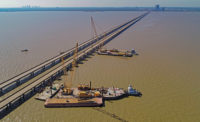The longest bridge in the United States is receiving its largest upgrade in almost a half century.
Preliminary work is under way on roughly $100 million in construction projects for the 24-mile Lake Pontchartrain Causeway bridge, just outside of New Orleans.
The improvements will consist of a $40 million project to add taller guardrails to the southbound span of the bridge, and a roughly $60 million project to add six sections of 1,008-ft. shoulder to both spans of the bridge.
“These are the most significant safety improvements for the Causeway in 50 years, so it’s truly getting us into the 21st century,” says bridge General Manager Carlton Dufrechou. The last improvement of this magnitude was the completion of the bridge’s second span in 1969.
Crews with Boh Bros. Construction Co., the construction manager at risk for the shoulder additions, drove three 120-ft. test pilings in August to determine load bearing capabilities. The project calls for a total 192 pilings of 90 to 120 feet, although the shorter pilings would cost less. A final analysis on the piling length is pending.
The guardrail will be a design-bid-build project, and Causeway officials expect to award a bid in late October. Volkert Inc. is the engineer for the shoulder project, and Gulf Engineers & Consultants is the engineer for the new guardrails.
Use of the CMAR process has expedited the design and planning of the shoulder additions allowed the project team to troubleshoot some key challenges, Dufrechou says. Traffic is one of the primary considerations. To minimize traffic disruptions, the contractor has opted for precast construction elements – including concrete piles, pile caps and decks — that will be manufactured offsite. Production is under way, and the piles will be ready for delivery and installation in late October. With this strategy, lane closures will need to take place only when crews remove the existing barriers and when they add the new structures, and only during pre-dawn hours.
Working in Lake Pontchartrain presents another challenge. “Shallow water depths and changing weather conditions can result in rapid changes in the construction environment,” says Ed Scheuermann, project principal with Boh Bros. “Our overall construction approach will help minimize these impacts as deliveries can be scheduled based on anticipated weather conditions.”
Concerns about commuter safety necessitated the shoulder and guardrail improvements. “The challenge is we have 20th-century designs and 21st-century conditions,” Dufrechou says.
In 1969, 2 million vehicles crossed the bridge annually. Today, there are 12 million vehicles a year and 40,000 cars daily. There are eight to 12 breakdowns on the bridge daily, and about 180 crashes a year. The bridge has no shoulders, which makes rear-end accidents more common. Disabled vehicles must use one of seven crossovers, spaced 3.5 miles apart.
“They were never intended to be emergency stopping areas, but that’s what they’re used for every day,” Dufrechou says.
The height of the existing guardrails presents another safety concern. Since 1994, 17 cars have gone over the rails and plunged into the lake, resulting in 13 fatalities. Of those accidents, 16 were on the older southbound span. The southbound guardrail is 25 in. high, compared to 31 in. on the newer northbound span. The guardrail project would raise the height of the rail to 46 in.
Both improvement projects are slated for completion by late December 2019, and the first shoulder could open by late May or early June, Dufrechou says.





Post a comment to this article
Report Abusive Comment